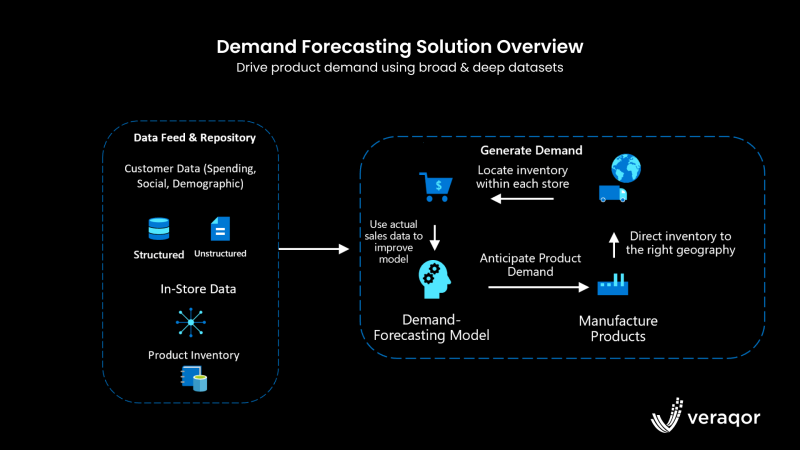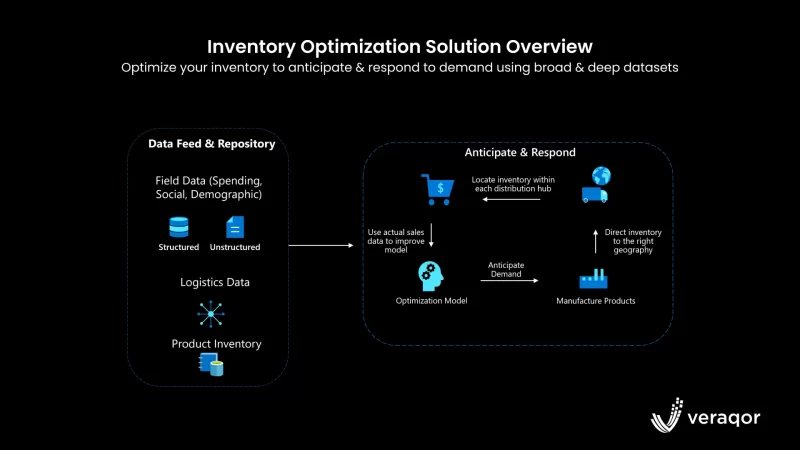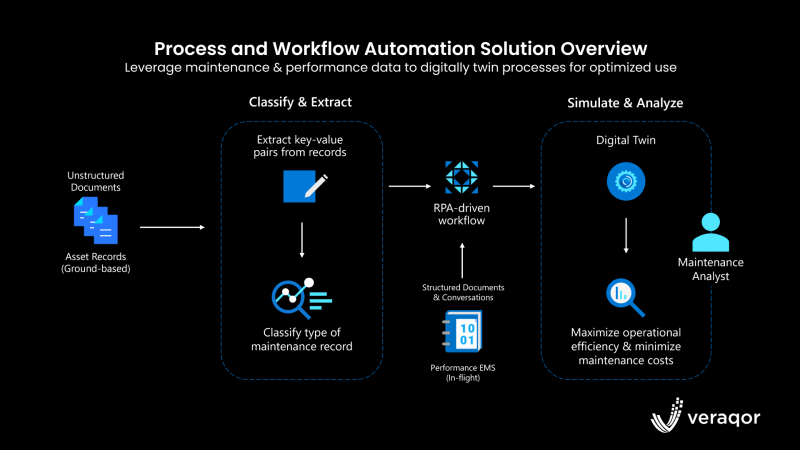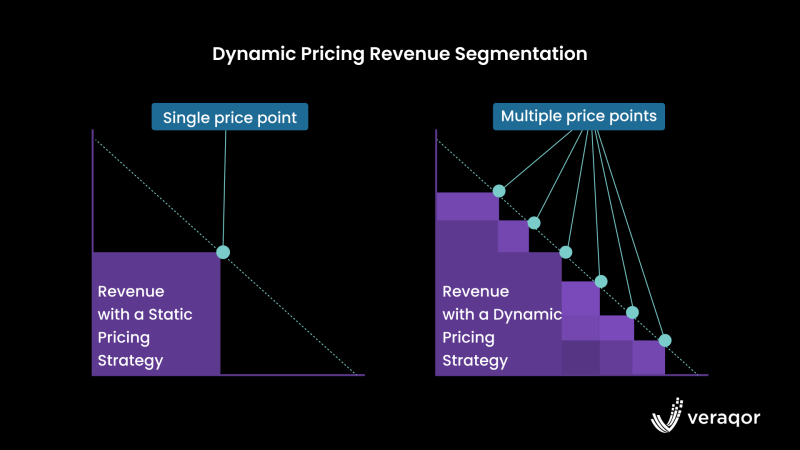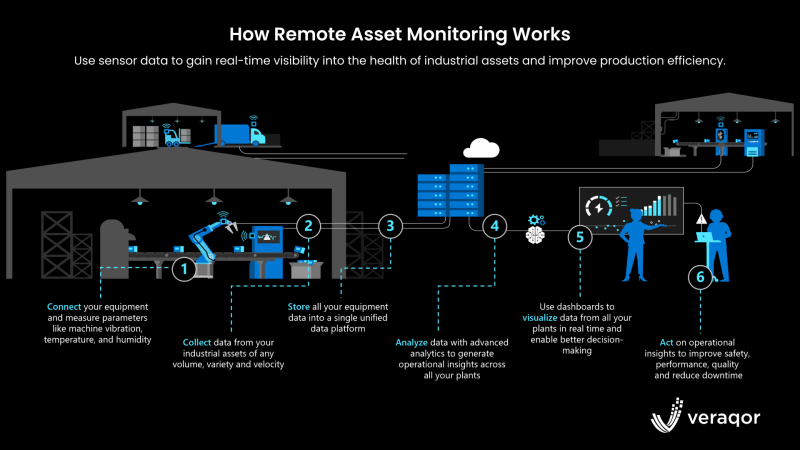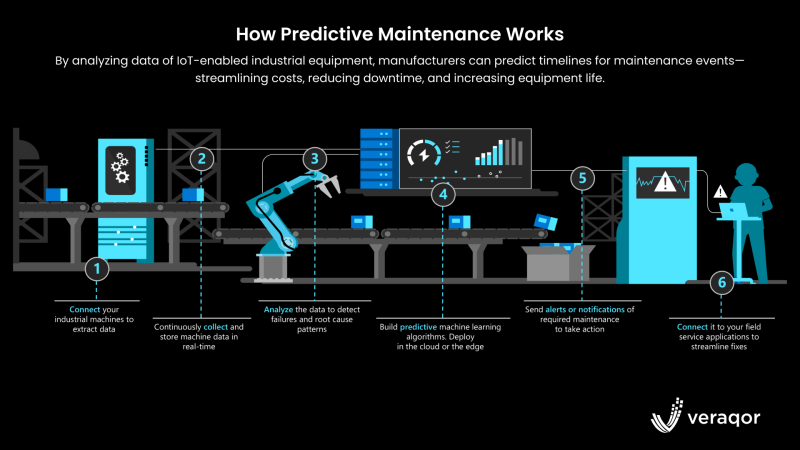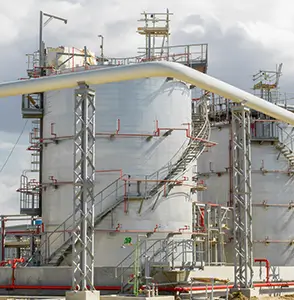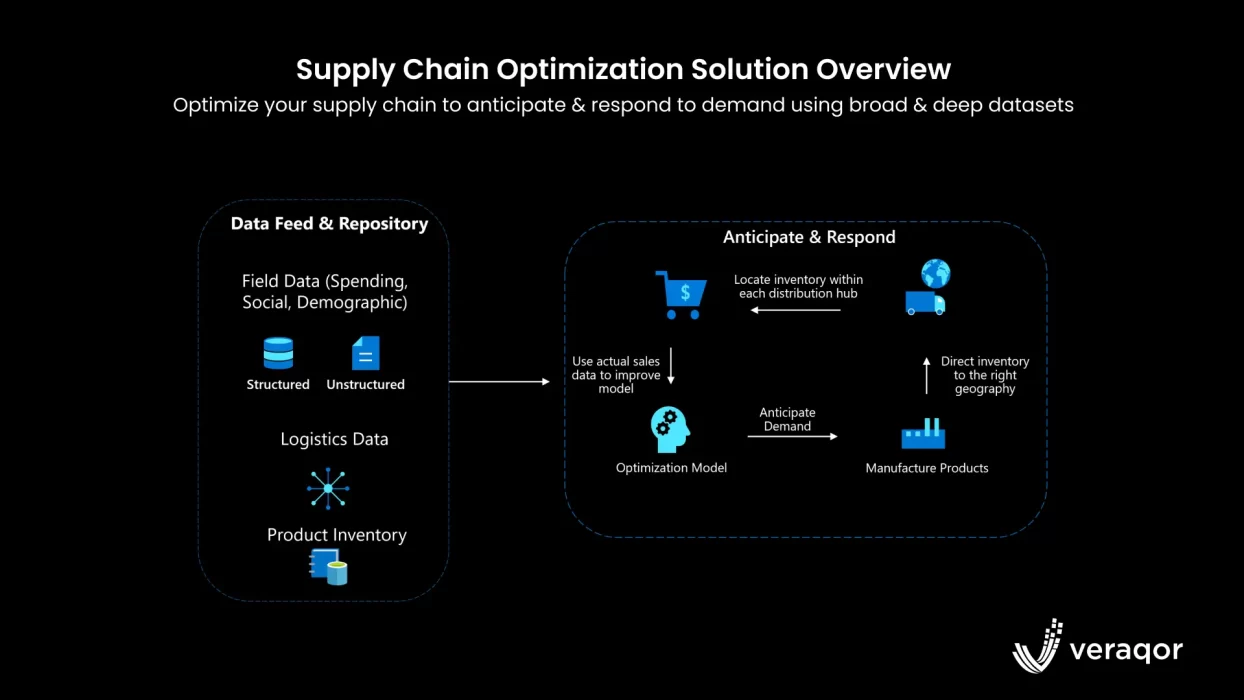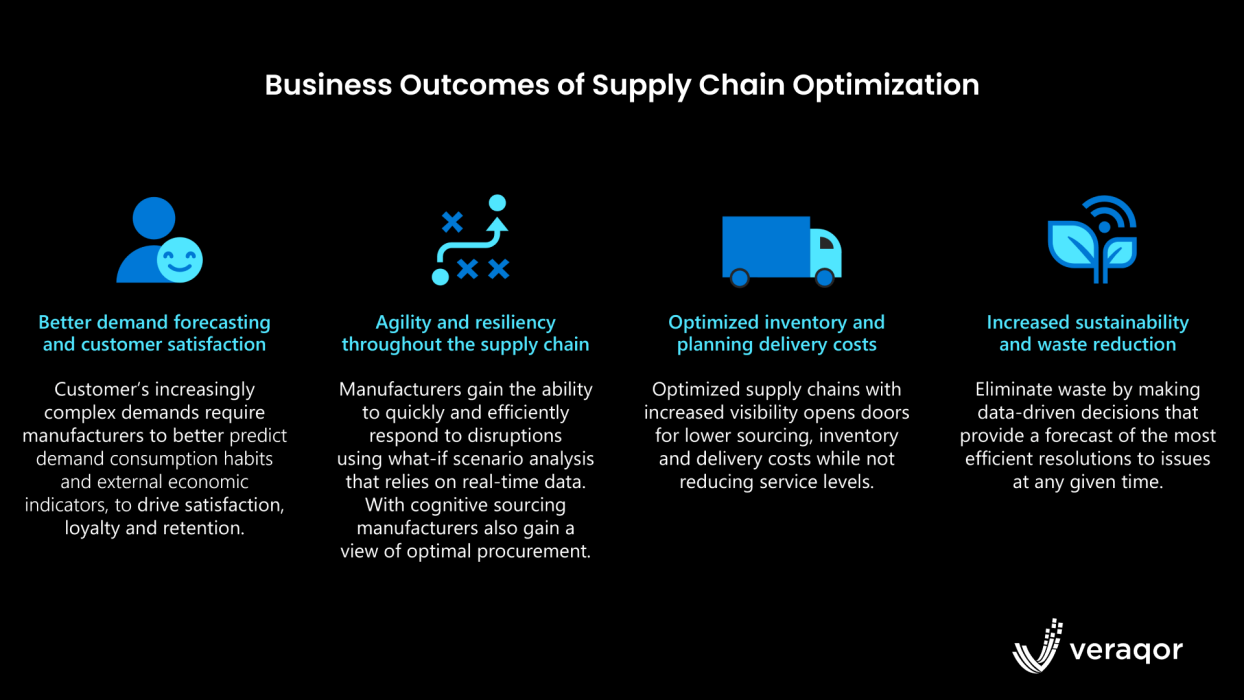Supply Chain Technology Solutions
Build Resilient Supply Chain
Shape Your Supply Chain with AI and Data-Driven Practices to Predict Demand, Sense Changes, and Quickly Respond to Unplanned Events
Overcoming Supply Chain's Biggest Challenges
Understanding Customers
- No Visibility into Customers' Preferences
- Unable to Understand Buying Habits
Unoptimized Supply Chain
- Order Fulfillment and Promising
- Logistics Network – Track and Trace
Poor Overall Equipment Effectiveness (OEE)
- Inefficient Production and Unplanned Downtime
- High Inspection & Maintenance Costs
Upgrade to a Resilient, Connected & Sustainable Supply Chain
- Intelligent SCM
- Automated Manufacturing Processes
- Localized Dynamic Pricing
- Real-time Asset Tracking
- IoT-enabled Predictive Maintenance
Demand Forecasting
Key Benefits
Reduce inventory carrying costs with improved stock management and forecasting of customer demands
Streamline production schedules, and expedite transfers and shipments for optimal distribution
Technical Capabilities
Data and AI for Accurate Store Inventory Management
By using predictive analytics and machine learning, retailers can understand customer behavior patterns in real time and take proactive steps to ensure optimal inventory levels. AI technologies help automate processes such as forecasting demand and identifying when an item needs to be restocked or removed from the shelves. By utilizing these tools, stores can quickly respond to changes in demand without overstocking or understocking their shelves, leading to improved profits and customer satisfaction.
Using AI and Data to Enhance Retail Logistics
By leveraging predictive analytics and machine learning models, businesses can proactively anticipate changes and make informed decisions and effectively manage their stock. Additionally, these processes can help automate transfer requests between stores in different locations, ensuring that any extra stock is moved to meet customer demand swiftly. This helps to avoid stock limitations as well as improves profits and customer satisfaction by delivering on time with the right product quantity.
Demand Forecasting Trends
Organizations experienced a 30% increase in optimized inventory through the use of a demand-driven supply chain.
70% of retailers indicate that AI and Machine Learning will be their top technology choices for forecasting and demand planning.
Inventory Optimization
Delivering the ability to analyze historical sales data, market trends, lead times, and supplier performance for accurate inventory forecasts and optimal inventory levels.
Providing valuable insights into inventory performance and identifying slow-moving or excess inventory.
Using the power of AI to improve supply chain efficiency, customer experience, and satisfaction.
Key Benefits
More accurate predictions of customer demand, allowing for efficient inventory planning
Increased visibility into supply chain processes for increased efficiencies
Reduced costs associated with unnecessary overstocking and deadstock
Technical Capability
AI/ML-based Inventory Management
Boost business resilience by quickly responding to disruptions and intelligently selecting alternatives for supply shortages.
Inventory Optimization Trends
60% of consumers are more likely to become repeat buyers after a personalized shopping experience with a retailer.
Using Big Data Analytics in the retail industry can increase operating margins by up to 60%.
57% of retailers use artificial intelligence (AI) to optimize inventory management.
Process and Workflow Automation
Make insightful & proactive business decisions based on critical data through AI and digitally simulate complex systems in near real-time.
Key Benefits
Improve operational efficiency and reduce costs by having access to data-driven insights
Make informed decisions based on real-time data analysis, enabling quick responses to market changes and emerging trends
Technical Capability
Form Recognizer
Transform large volumes of records into actional data, digitize unstructured documents, including handwritings, and go beyond OCR to classify the type of document and extract field names and values.
Process and Workflow Automation Trends
60% of all executives plan to build hybrid models for production and non-production processes over the next three years.
AI-based solutions are expected to spur 76% increase in worker production.
More than 75% of all chemical companies have doubled the level of digitization in past years.
Localized Dynamic Pricing
Localized dynamic pricing enables businesses to tailor their offerings according to business locations, regional economic trends, exchange rates, and other factors, thereby maximizing revenue, increasing customer loyalty, and capturing new markets.
Key Benefits
Better supply chain decisions and greater insight into product performance and profitability analysis
Localized dynamic pricing helps brands to be perceived as competitive, innovative, and customer-focused.
Technical Capabilities
Predictive Analytics
Predictive analytics can help forecast demand based on historical data and trends, which can help companies adjust their pricing strategy accordingly. Machine learning algorithms can be used to identify patterns in data and make predictions accordingly.
Real-time Monitoring
Real-time monitoring of inventory levels and sales data can help companies adjust their pricing strategy in real-time. This can help ensure that products are priced appropriately to meet demand and avoid stockouts.
Competitive Analysis
AI-powered competitive analysis tools can help companies monitor competitor pricing and adjust their own pricing strategy accordingly. This can help companies remain competitive and avoid overpricing or underpricing their products.
Price Optimization through Demand Sensing
Demand sensing solutions use machine learning algorithms to predict demand in real-time based on factors such as weather, seasonality, and promotional activity. This can help companies adjust their pricing strategy to reflect changes in demand.
Localized Dynamic Pricing Trends
A survey by Revionics found that 48% of retailers plan to implement dynamic pricing in the next few years.
More than 40% of all e-commerce transactions will involve some form of AI-based dynamic pricing.
77% of consumers said they were more likely to make a purchase when offered personalized pricing based on their location.
51% of retailers are already using some form of dynamic pricing, while 30% plan to implement it in the coming years.
Real-time Asset Tracking
Leverage the power of data and AI to maximize the efficiency and reliability of your asset-tracking system. Get real-time insights into asset utilization, location, movement, and behavior using geo-location, RFID, and IoT sensors.
We make it easy to access key metrics and critical information to ensure secure and optimized operation.
Key Benefits
Real-time location tracking to ensure optimized delivery schedules, decreased inventory loss and theft
IoT-enabled warehouse management to monitor warehouse parameters such as humidity, temperature, and pressure to mitigate inventory damages
Equipment monitoring through real-time critical indicators such as equipment temperatures, vibrations, etc., to better predict machine downtime
Technical Capability
Real-time Assets and Shipments Tracking
Optimize logistics processes with visibility into goods in transit, notify stakeholders about deviations, and monitor fulfillment, while monitoring equipment and inventories to mitigate any loss of stock and machinery.
Real-time Asset Tracking Trends
IoT, AI, and big data analytics can bring down logistical costs by up to 15%.
Optimizing supply chain and logistics processes can improve operational efficiency by up to 25%.
Predictive Maintenance
AI-empowered predictive maintenance boosts equipment reliability and helps manufacturing organizations stay ahead of unexpected issues that can easily disrupt production. By analyzing metrics and data related to the lifecycle maintenance of IoT-enabled equipment through predictive maintenance, companies can predict both timelines for probable maintenance events and upcoming capital expenditure requirements, allowing them to streamline their maintenance costs and avoid critical downtime.
Key Benefits
Optimized production scheduling
Improved Overall Equipment Effectiveness (OEE)
Reduced equipment downtime, maintenance and inspection costs
Technical Capabilities
Real-time Supply Chain Analytics
Unlock the power of real-time supply chain analytics with data and AI to gain valuable insights into how your business is performing, stay ahead of the competition, improve customer service, identify areas for improvement and measure KPIs. With the help of data and AI, you can assess all aspects of your supply chain from end-to-end in real time and make decisions quickly that will increase efficiency and profitability.
Supply Chain Processes Management
Data and AI can help to improve the management of supply chain processes by automating mundane tasks, increasing accuracy of data and reducing human error. With real-time insights from AI-driven analytics, companies can identify bottlenecks in the supply chain, predict future trends and make informed decisions about how best to maintain equipment efficiency and OEE. AI also enables more accurate forecasting of demand, reducing stock waste and ensuring that your business is always prepared for unexpected events such as lost orders or surges in customer demand.
Predictive Maintenance Trends
74% of oil and gas companies use some form of predictive maintenance to reduce unplanned downtime.
The global predictive maintenance market in the oil and gas industry is expected to grow at a CAGR of 25.7% from 2021 to 2028.
Predictive maintenance can reduce unplanned downtime by up to 50%, ensuring better outcomes for enterprises.
Companies that use predictive maintenance experience a 27% increase in equipment availability and a 30% reduction in maintenance costs.
Industry Scenarios
Generating Business Value Across Industries
Enterprise solutions that provide real-time, actionable insights.
Intelligent supply chain solutions empower organizations to excel in their roles. By providing quantitative insights and optimizing every aspect of the supply chain, latest technology ensures that the right products reach customers efficiently, whether they work or live. This includes accurate demand forecasting, enhanced stock management, streamlined production schedules, and expedited shipments.
COOs are leveraging AI-empowered predictive maintenance to maximize equipment reliability and enhance production efficiency. By proactively addressing maintenance needs, organizations optimize production scheduling, improve OEE, and significantly reduce equipment downtime and associated costs. This strategic approach fosters sustainable growth and operational resilience.
The purpose-built insights solution for call center insights enables useful information delivery to the right individuals, assisting in performance improvement in usual call center operations. This solution keeps track of all the important information, including dates, times, and durations of all the steps, and mitigates any potential risks, including dropped calls, increasing resource requirements, and more. Furthermore, the solution covers agent-level insights such as periodic performances, additional support provision, business assistance, and more.
Developing AI-powered algorithms can help healthcare providers optimize resource allocation, reduce waste, and improve operational efficiency in hospitals and healthcare systems. This can help reduce costs while improving the quality of care for patients. AI-powered algorithms can analyze data from various sources, including patient records and supply chain data, to identify zones where costs can be reduced without sacrificing patient care.
This solution enables oil and gas companies to dive deep into their data and gain insights regarding their supply chains, allowing them to identify inefficiencies and anomalies and capitalize on opportunities for process optimization. Using the cloud, real-time collaboration, and sharing data among stakeholders make supply chain operations more effective, resulting in better yield.
This solution helps CXOs gather and analyze data from various sources. The seismic imaging data, geological surveys, historical product data, and other sensor data can be processed through cloud analytics tools to help oil and gas exploration companies to be more specific with their exploration and production planning, reducing risks and improving overall efficiency, leading to ideal results.
This solution helps companies assess their capacity, requirements, and demand and build accurate reservoir models, eventually leading to optimized production and better recovery rates. These models function by incorporating data gathered from multiple sources, such as seismic imaging, historical production data, sensors, and more.
See How Organizations Are Innovating

Instant insights of fruit and vegetable availability status on shelves
Situation
Solution
Impact

+200% revenue vs. expectation in new store locations selected using Azure ML
Situation
Solution
Impact
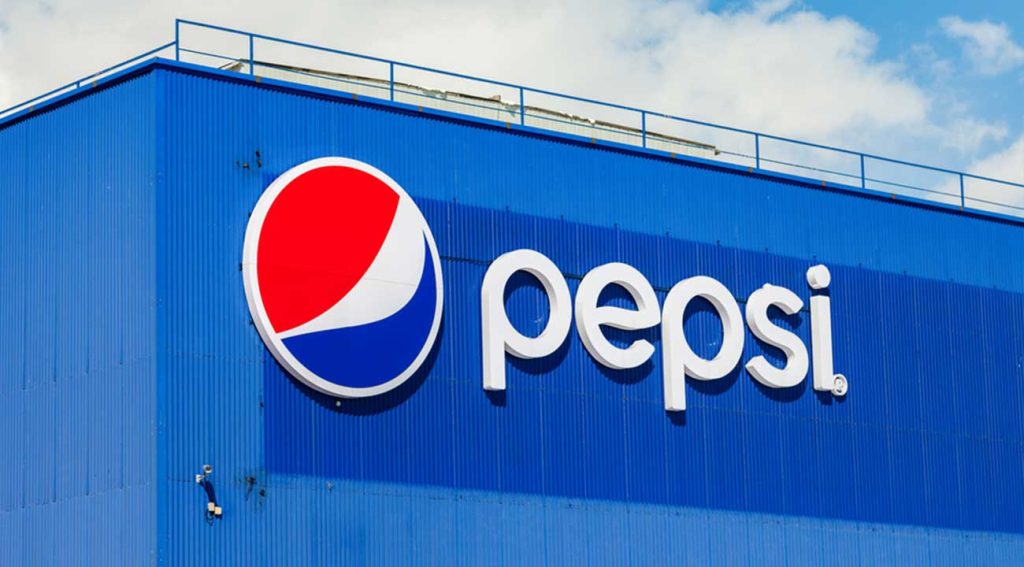
+40% improvement in prediction accuracy in a pilot of over 700 retail stores
Situation
Solution
Impact
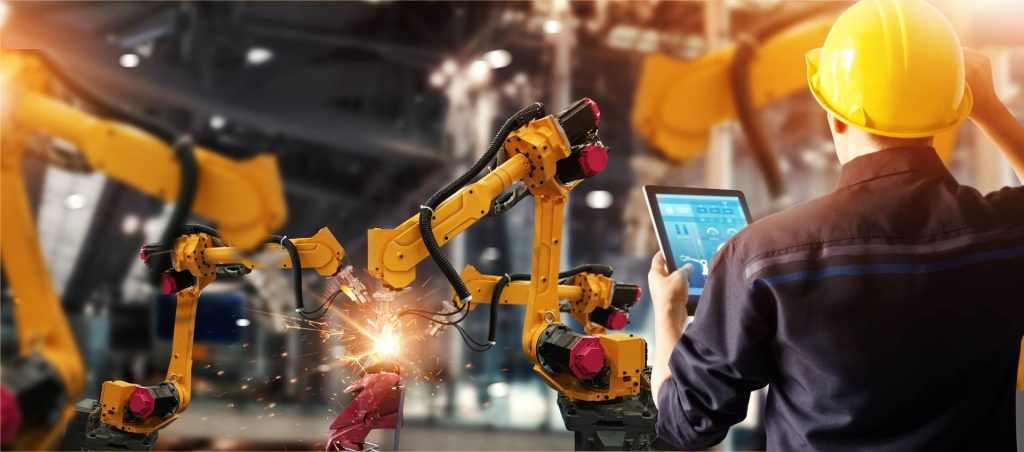
On one hand, Microsoft Azure is continuing to emerge as the most sought-after cloud platform that is allowing us to build cutting-edge solutions, bridging the value of the intelligent cloud and intelligent edge coming together. On the other hand, we’re really enthused by the vision of Piramal Glass to transform traditional processes in the Digital-1st world.”
Situation
Piramal Glass was looking to improve production efficiency and minimize defects to transform its manufacturing process with technology.
Solution
Piramal Glass leveraged IoT to get real-time visibility into its manufacturing operations and analyze the defects at various stages. Using Azure IoT Hub, data from equipment and high-speed production line sensors is pushed to the cloud for further analysis.
Impact
RTMI (Real Time Manufacturing Insights) has enhanced the efficiency of plant managers in detecting the anomalies in the process, monitoring the key performance metrics and making informed decisions in real time, reducing time on manual data and improving productivity.
How We Can Help?
Gain optimization through collaborative sessions to take supply chain strategies up a notch with dedicated support.
The advisory session explores the impact of digital transformation and innovation to help our customers with vision-setting, strategy, roadmaps, and organizational alignment.
Duration: 1 Hour
Investment: Free
The assessment phase is designed to help you understand how your technical landscape can be modernized and optimized for innovation, performance, and growth, with ideal supply chain solutions for unique situations.
Duration: 3 Weeks
In this multi-week, in-depth engagement, Veraqor's expert architects work closely with key members of your technical staff to transfer knowledge and prove our customized solutions.
Duration: 6 Weeks
The tactical implementation of supply chain technology solutions for your organization by Veraqor's certified engineers is carried out with great precision. All the modules of the system are comprehensively taken care of till the solution is fully live and functioning smoothly.
Duration: 15 Weeks
These custom sessions include a hands-on environment where you can experience the working of your customized chain technology solutions, delivered by our expert trainers.

